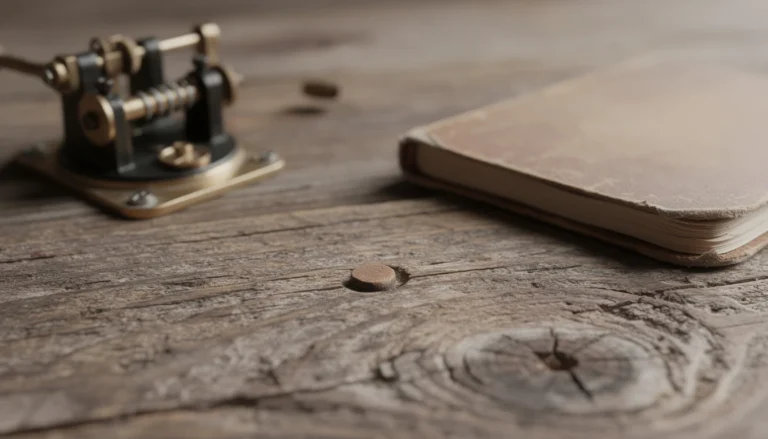Key Takeaways
- “I love you” in Morse code is: .. / .-.. — …- . / -.– — ..- (I = .., LOVE = .-.. — …- ., YOU = -.– — ..-)
- Follow standard timing for clarity: dot = 1 unit, dash = 3, gap within a letter = 1, between letters = 3, between words = 7
- Send it by tapping, flashing a light, beeping with a tone app, or texting the dots and dashes; keep a steady beat for accuracy
- Practice with anchors like SOS and mnemonics (di/dah sounds) to lock in rhythm and letter recall
- Avoid common errors: uneven timing, missing inner-letter gaps, rushed dashes, or mixing non-ITU Morse charts
- Turn the message into gifts or posts: bead bracelets, engraved rings, minimalist graphics, or captioned reels with the code
I’ve always loved secret messages and Morse turns simple dots and dashes into feelings. When I wanted to say I love you in a clever way Morse felt perfect. It’s classic discreet and a little romantic.
In this guide I’ll show how Morse code works just enough to send I love you and share easy ways to tap blink or text it. You can use it for a sweet note a bracelet pattern or a late night light signal. It feels playful and heartfelt. Ready to turn love into dots and dashes Let’s start.
What Is Morse Code?
Morse code is a two-symbol system that encodes text as dots and dashes for sound, light, or touch. I use it to say love messages with precise timing and spacing. The modern form follows the ITU standard from 2004 for international use (ITU-R M.1677-1, https://www.itu.int/rec/R-REC-M.1677-1-200910-I). The code dates to the 1830s and 1840s with Samuel F. B. Morse and Alfred Vail for telegraphy (Encyclopaedia Britannica, https://www.britannica.com/technology/Morse-Code). Amateur radio groups maintain training resources and practice materials today (ARRL, https://www.arrl.org/what-is-ham-radio).
I time each element with uniform units for clarity.
| Element | Symbol | Duration in units | Gap in units |
|---|---|---|---|
| Dot | . | 1 | 1 within a letter |
| Dash | – | 3 | 1 within a letter |
| Letter gap | — | — | 3 between letters |
| Word gap | — | — | 7 between words |
I map each letter or numeral to a unique pattern. The set covers 26 letters, 10 digits, and selected punctuation, for example period, comma, question mark, slash, and equals (ITU-R M.1677-1). The code ignores case and accents in the basic set.
I practice with a few anchors that keep my say love code clean.
- Send consistent timing, then raise speed once accuracy feels solid
- Send clear spacing, then place 3 units between letters and 7 between words
- Send simple patterns first, then add longer letters like L and Q
- Send short sessions daily, then test copy with random words
I translate love phrases by letters. I is .., L is .-.., O is —, V is …-, E is ., Y is -.–, U is ..-. I space each letter by 3 units, I space each word by 7 units. I say I love you in code by sounding or flashing these exact sequences in order.
I choose the medium that fits the moment.
- Tap table or wall for tactile signals, then keep taps even on a metronome
- Blink flashlight or phone screen for visual code, then hold dashes three times longer than dots
- Beep with a tone app for audio code, then keep tone pitch constant
- Text dots and dashes for digital messages, then add slashes between words for readability
I keep a quick reference for fast love code work.
- Use SOS as a timing check, then send … — … at steady pace
- Use prosigns like AR for end of message, then avoid extra spaces
- Use ITU timing units, then align practice with standard charts
- ITU-R M.1677-1 International Morse code, https://www.itu.int/rec/R-REC-M.1677-1-200910-I
- Encyclopaedia Britannica Morse Code overview, https://www.britannica.com/technology/Morse-Code
- ARRL learning resources, https://www.arrl.org/what-is-ham-radio
The Morse Code For “I Love You”

I say I love you in Morse code with precise letters and strict timing. I follow ITU standards for consistency per ITU-R M.1677-1 and ARRL references.
Letter-By-Letter Code: I, Love, You
I encode each letter of the phrase as dots and dashes.
| Letter | Morse | Elements | Notes |
|---|---|---|---|
| I | .. | 2 | two dots |
| L | .-.. | 4 | dot dash dot dot |
| O | — | 3 | three dashes |
| V | …- | 4 | three dots and a dash |
| E | . | 1 | single dot |
| Y | -.– | 4 | dash dot dash dash |
I transmit the words with standard gaps.
- Phrase: .. for I, .-.. — …- . for LOVE, -.– — ..- for YOU
- Pattern: .. / .-.. — …- . / -.– — ..-
- Spacing: 3 units between letters, 7 units between words
Sources: ITU-R M.1677-1, International Morse Code, 2009 update, and ARRL Morse resources
Dots, Dashes, And Spacing Rules
I apply fixed unit timing for each Morse code element per ITU.
| Timing Item | Duration in Units |
|---|---|
| Dot | 1 |
| Dash | 3 |
| Gap between dots and dashes within a letter | 1 |
| Gap between letters | 3 |
| Gap between words | 7 |
- Elements: use 1 unit for a dot and 3 units for a dash for letter clarity
- Letters: keep 1 unit inside letters and 3 units between letters for readability
- Words: wait 7 units between words for clear separation
- Speed: set a consistent dot length for the whole message for even rhythm
How To Say “I Love You” In Morse Code

I encode I love you as .. / .-.. — …- . / -.– — ..-. I keep timing even so each letter and word reads clean.
Speaking Or Tapping The Rhythm
- Tap I as .. then pause 3 units before L as .-..
- Tap O as — then pause 1 unit inside letters and 3 units between letters
- Tap V as …- then tap E as .
- Tap a 7 unit gap between love and you then tap Y as -.–
- Tap O as — then tap U as ..-
- Keep a steady unit like 200 ms for a dot if you want consistent speed
- Say dot for . and dash for – if tapping feels awkward
Morse Rules And Units
| Unit type | Length in units |
|---|---|
| dot | 1 |
| dash | 3 |
| gap inside a letter | 1 |
| gap between letters | 3 |
| gap between words | 7 |
Letters In “I LOVE YOU”
| Letter | Morse |
|---|---|
| I | .. |
| L | .-.. |
| O | — |
| V | …- |
| E | . |
| Y | -.– |
| O | — |
| U | ..- |
Flashing Light Or Texting The Pattern
- Flash dots as short blinks and dashes as long blinks
- Hold a long blink 3 dot units and a short blink 1 dot unit
- Space blinks 1 unit inside letters and 3 units between letters
- Space words 7 units then continue
- Send this exact text pattern if typing: .. / .-.. — …- . / -.– — ..-
- Text dots and dashes only if the app strips slashes
- Add a hint like MORSE at the end if the recipient likes puzzles
Practice Tips And Memory Tricks

Practice locks in the rhythm for how to say I love you in Morse code. I use quick drills and tiny cheats to keep timing clean.
Simple Mnemonics For I, L, And Y
I anchor each letter to a short cue, then I repeat it with a steady beat.
- Trace I with twins, count two taps for two dots.
- Trace L with a lead long, say dot dash dot dot as di dah di dit.
- Trace Y with a yank back, say dah di dah dah with a firm first beat.
I map letters to tight hooks for fast recall.
| Letter | Morse | Elements | Audio cue examples | Kinesthetic cue examples |
|---|---|---|---|---|
| I | .. | 2 | di dit, tick tick | two taps, two blinks |
| L | .-.. | 4 | di dah di dit, tip ta tip tit | tap hold tap tap |
| Y | -.– | 4 | dah di dah dah, dum di dum dum | hold tap hold hold |
I drill the trio inside the full phrase for context.
- Group I L, tap .. then .-.. with a 3‑unit letter gap.
- Group Y U, tap -.– then ..- with a 3‑unit letter gap.
- Group love, say L O V E as di dah di dit, dah dah dah, di di di dah, dit.
Creative Ways To Use Morse Code In Romance
Creative Morse code ideas add playful romance to how I say I love you. Creative formats keep the dot dash rhythm clear across gifts and posts.
Gift And Craft Ideas
Gift and craft ideas turn Morse code into keepsakes I can hold.
- Engrave a ring interior with the dot dash for I love you, if subtle style suits the moment.
- Stitch a pillow edge with short long stitches for the phrase, if cozy decor fits the room.
- Bead a bracelet with short beads for dots and long beads for dashes, if tactile patterns help the rhythm.
- Burn a wood plaque with spaced lines for letters and wider gaps for words, if rustic design matches the space.
- Emboss a leather bookmark with the code and a tiny heart divider, if daily reading anchors the habit.
- Fold a card front with raised dots and scored dashes, if paper craft sets the mood.
- Knot a friendship bracelet with 2 colors for dots and dashes, if color contrast guides quick reads.
- Cast a wax seal stamp that hides the code in the emblem, if vintage detail fits the vibe.
| Item | Count | Use |
|---|---|---|
| Letters in I LOVE YOU | 8 | Charms or panel segments |
| Symbols in the code | 24 | Beads or knots per symbol |
| Word gaps in the phrase | 2 | Larger spacer beads for breaks |
Digital And Social Media Uses
Digital and social media uses carry Morse code across screens and streams.
- Animate story frames with blink on for dashes and blink off for dots, if silent viewing leads engagement.
- Caption a reel with spaced dots and dashes plus a clear key, if new viewers meet the code first.
- Layer haptic taps in a short clip for the phrase, if sound off viewing dominates.
- Schedule a text drop that sends the 3 words in code at sunset, if timing marks a shared date.
- Design a profile banner with minimalist dots and dashes, if clean lines match the brand.
- Add a bio line that says I love you in Morse code, if concise signals fit the space.
- Share a live light flash using a desk lamp, if quick calls need a low tech cue.
- Gamify a post with a code puzzle and a tiny prize, if interaction boosts reach.
Common Mistakes To Avoid
Common mistakes to avoid when I say I love you in Morse code center on timing, spacing, and symbol accuracy.
| Element timing | Duration in units |
|---|---|
| Dot | 1 |
| Dash | 3 |
| Gap between dits and dahs within a letter | 1 |
| Gap between letters | 3 |
| Gap between words | 7 |
- Mixing unit lengths breaks readability for letters like I, L, O, Y.
- Missing inner-letter gaps merges patterns inside L .-.. and Y -.–.
- Overstretching letter gaps into word gaps splits LOVE into L O V E.
- Rushing dashes shortens O — and Y -.– into unclear noise.
- Dropping final dits truncates U ..- and V …- into wrong letters.
- Confusing similar patterns swaps I .. with E . or S …, and swaps U ..- with V …-.
- Ignoring the 7-unit word gap blurs I LOVE YOU into one word.
- Using non-ITU charts introduces American Morse variants for letters like L and Y.
- Mixing mediums without tempo alignment skews timing when I switch from tapping to blinking.
- Skipping a steady beat removes consistency when I time dots, dashes, and gaps.
Conclusion
Morse turns three little words into a tiny adventure. I love how a simple rhythm can feel both secret and sincere. When you send it you are not just saying it you are crafting a moment that only the two of you share.
Take a breath and play. Share a tiny pulse of meaning in your own style. Let it live in a moment or a keepsake. Keep it light. Keep it steady. Watch a small signal spark a big smile. If you try it today tell me how it went. I am cheering for you.
Frequently Asked Questions
What is Morse code and how does it work?
Morse code is a system that uses dots and dashes to represent letters and numbers. You send it through sound, light, or touch using short (dot) and long (dash) signals with set timing and spacing. Following the ITU standard ensures your message is clear and readable anywhere.
How do you say “I love you” in Morse code?
“I love you” in Morse code is:
I = ..
L = .-..
O = —
V = …-
E = .
Y = -.–
O = —
U = ..-
Keep one unit between parts of a letter, three units between letters, and seven units between words.
What’s the correct timing in Morse code?
Use a fixed unit. A dot = 1 unit, a dash = 3 units, space between elements = 1 unit, between letters = 3 units, and between words = 7 units. Keep a steady tempo to avoid confusion.
Can I tap “I love you” in Morse code?
Yes. Tap light for a dot and longer for a dash. Keep one beat between parts of a letter, three beats between letters, and seven between words. Practice slowly, then speed up while staying consistent.
How do I send “I love you” with light signals?
Use a flashlight or phone screen. Short flash for dot, longer flash for dash. Keep the ITU timing: 1 unit on for a dot, 3 for a dash, with proper gaps. Practice with SOS (… — …) to check your rhythm.
Can I blink Morse code for “I love you”?
Yes. Blink quickly for dots and hold longer for dashes. Keep your timing consistent so each letter is clear. It works best at close range and with someone who knows Morse basics.
How do I text “I love you” in Morse code?
Type dots and dashes with spaces: “.. / .-.. / — / …- / . / -.– / — / ..-”. Use a slash or three spaces between letters, and seven spaces between words to mimic timing.
What are common mistakes to avoid?
Don’t rush dashes, mix unit lengths, or skip the gaps between letters and words. Avoid non-ITU charts and don’t switch mediums (tap, light, audio) without matching tempo. Consistency is key to clarity.
What are some practice tips for beginners?
Start with simple letters (E = . , T = -) and common patterns. Use a metronome to lock timing. Drill SOS to calibrate speed. Practice “I love you” slowly, then increase tempo while keeping spacing clean.
Are there memory tricks for “I love you” letters?
Try mnemonics: I = “twins” (..), L = “lead long” (.-..), O = “long long long” (—), V = “three then long” (…-), E = “single dot” (.), Y = “yank back” (-.–), U = “two then long” (..-).
What creative ways can I use Morse code romantically?
Engrave rings, stitch pillows, knit scarves, or bead bracelets using dot-dash patterns. Send light-flash messages, caption reels with animated Morse, or design a profile banner that spells “I love you.”
How do I keep my Morse messages consistent?
Pick a unit length (like one second) and stick to it. Count beats for dots, triple for dashes, and respect letter and word gaps. Practice with the same tool—tapper, light, or tone—before mixing mediums.



